Classic Italy tours
Venice, Como and the lakes | Cremona, Mantova, the Alps, Ortisei, Val Gardena | Pisa, Assisi, Siena, Florence, S. Gimignano | The Amalfi Coast and Isle of Capri | The Magical South and Sicily
Cremona, Mantova, Riva del Garda,Ortiseri, the Alps, Val Gardena, San Marino
Trentino Alto Adige is located on the extreme north of Italy, bordering on Austria, Veneto, Lombardy and Switzerland. The region is dominated by Alpine climate with cold and snowy winters, cool summers, rainy springs and autumns.Some dells of Adige valley have milder climate. Because of very little intervention of man in the natural landscape of the region, it conserved its original beauty, flora and fauna. This is a mainly mountainous region, rich in rivers and lakes and with chains of mountains divided in two by the valley of the river Adige. To the west one finds the glaciers of the group Adamello, Presanella, Care Alto and the group of Brenta. To the east the groups of Lagorai, Latemar, the Dolomites of Fassa, and the Pale di S. Martino. There are many alpine valleys: the Valsugana, the Vallarsa, the Val di Non, the Val di Sole, the Val di Cembra, Fiemme and Fassa. The main lakes are those of Garda, Caldonazzo, Tovel and Ledro. This region also hosts three natural parks: Adamello-Brenta, Paneveggio-Pale of S. Martino and Stelvio.
Tour suggested of 7 days and 6 nights starting from Rome, with the visit of Cremona, Mantova, Ortisei and the Alps and Val Gardena, the service is driver/guided and is individually personalized.
Venice, Como and the lakes | Cremona, Mantova, the Alps, Ortisei, Val Gardena | Pisa, Assisi, Siena, Florence, S. Gimignano | The Amalfi Coast and Isle of Capri | The Magical South and Sicily
Cremona, Mantova, Riva del Garda,Ortiseri, the Alps, Val Gardena, San Marino
Trentino Alto Adige is located on the extreme north of Italy, bordering on Austria, Veneto, Lombardy and Switzerland. The region is dominated by Alpine climate with cold and snowy winters, cool summers, rainy springs and autumns.Some dells of Adige valley have milder climate. Because of very little intervention of man in the natural landscape of the region, it conserved its original beauty, flora and fauna. This is a mainly mountainous region, rich in rivers and lakes and with chains of mountains divided in two by the valley of the river Adige. To the west one finds the glaciers of the group Adamello, Presanella, Care Alto and the group of Brenta. To the east the groups of Lagorai, Latemar, the Dolomites of Fassa, and the Pale di S. Martino. There are many alpine valleys: the Valsugana, the Vallarsa, the Val di Non, the Val di Sole, the Val di Cembra, Fiemme and Fassa. The main lakes are those of Garda, Caldonazzo, Tovel and Ledro. This region also hosts three natural parks: Adamello-Brenta, Paneveggio-Pale of S. Martino and Stelvio.
Tour suggested of 7 days and 6 nights starting from Rome, with the visit of Cremona, Mantova, Ortisei and the Alps and Val Gardena, the service is driver/guided and is individually personalized.
| 1st Day: Cremona We will start the tour from Rome drive through the regions of Lazio, Umbria, Tuscany, Emilia Romagna, Lombardia and Trentino. Situated in the fertile lands of the Padana plains, Cremona origins date back to the Roman Empire. The city has for centuries been an important agricultural base. Cremona is known world wide for its lute making linked to the fame of the violins by Antonio Stradivari. It is no surprise to find here the Stadivariano Museum, the Antonio Stradivari International School of lute making, the Cremona Center of Lute making, and the International Instrument Institute together with numerous lute shops. Other sites of interest to the visitor include the Arches of Palazzo Comunale, the Civic Ala Ponzone Museum, the Museum of Rural Civilization, the Natural History Museum, The Organological-Didactic Museum, the Berenziano Museum, the Camerale History Museum, the Loggia dei Militi, the Torrazzo, Cremona Cathedral and the Baptistery. |
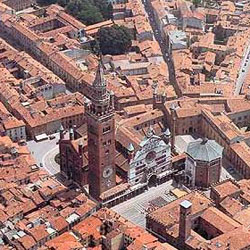 |
| 2nd Day: Mantova Of Etruscan origins, Mantova is a truly fascinating city, a treasure trove full of history and artistic masterpieces. Names which have made the town famous throughout the world include Mantegna, Pisanello, Leon Battista Alberti, Giulio Romano. The splendor of Mantova dates back to the dynasty of the Gonzaga Family, symbolized in the Palazzo Ducale. Wandering through the narrow streets and under the colonnades one can marvel at the Basilica of St Andrea, Mantova Cathedral, the Church of St Lorenzo, the oldest of the city's churches in Piazza delle Erbe, Palazzo del Podestà, Piazza Broletto, the Bibiena Theatre named after Antonio Gallio Bibiena who designed it, Palazzo D'Arco with the Giuseppe Bazzani Salone. Overnight stay in Mantova. |
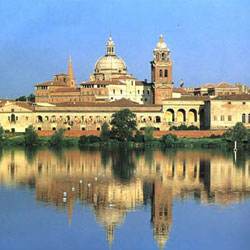 |
| 3rd Day: Riva del Garda Dominated by the spectacular scenery of Lake Garda, Riva del Garda is situated in a unique position, immersed in a patchwork of landscapes from the Mediterranean to the mountainous, framed by the Dolomites. It is a place with a great history and a culture of truly ancient origins, traces of which can be found in the various sites to be visited such as Piazza III Novembre, the Casa del Comune, Piazza S. Rocco, the Church of St Rocco and St Virgilio, Porta San Marco, the Apponale tower, Porta San Francesco, the Church of St. Maria Assunta, the Fort and the Civic Museum. In addition to the beauties of the Riva del Garda, those who enjoy excursions will love the walks which lead into the hills, where one can visit the Bastione, the Church of St Barbara, the Port of St Nicolò, the Villino Campi and Punta Lido. The districts of Riva del Garda are also worth visiting, districts such as San Tommaso, where one finds the small Church dedicated to the Archbishop of Canterbury, Thomas Becket and then there is Varone, Campi and Pregasina where one can admire the Church of St Giorgio. Overnight stay in Riva del Garda. |
 |
| 4th Day: Merano Encircled by a truly spectacular natural landscape, Merano is a city which offers a great deal to the tourist, from its Mediterranean climate and parklands to its typically Medieval center. Merano is a city which should be discovered gradually and in its entirety, starting from the historic center, situated in an area between the slopes of Monte Benedetto and the right bank of the Passirio River. The center of Merano is the Piazza del Duomo, historic site of the town. Traces of the town's medieval past can be found in the gateways of the city walls and the Polveriera tower situated on the top of the wall. There are numerous ecclesiastic buildings of historical interest such as the Cathedral, the small Church of St Barbara, the Church of St Spirito, the Church of St Maria del Conforto, the Church of St Giorgio, the Orthodox Church and the Synagogue. The Town Museum is also well worth visiting. |
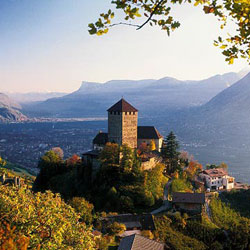 |
| 5th Day: Bressanone Situated towards the confluence of the Rienza and Inarco rivers, Bressanone is a city with an ancient history, the traces of which can still be seen today. Bressanone is characterized by a number of ancient roads, bridges, colonnades and churches which evoke the flavors of the past. There are also the Cathedral and cloisters, Palazzo Vescovi which now houses the Diocesan Museum and a number of Nativity scenes. The surroundings of the old part of Bressanone invite the tourist to relax and contemplate, to gaze out across a vista of hills, vineyards and orchards. Bressanone hosts a number of events throughout the year, the most famous of which is the Festa in the Historic Center, Caberet del Teatro in the "Anreiter" cellar, and numerous concerts. Bressanone is also a chosen destination for conferences and symposiums mainly held in the Nikolaus Cusano Academy. Local cuisine, known as "cucina della Valle isarco", will satisfy even the most demanding palates. |
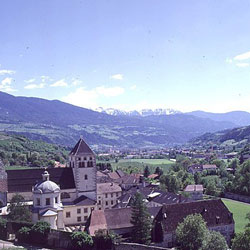 |
| 6th Day: Ortisei and Val Gardena Ortisei, the capital of the Val Gardena is situated at an altitude of roughly 1200 meters, at the feet of the Siusi Alps, below the woods of Rasciesa. There is a lively historic center, but Ortisei also offers the visitor relaxation in the quiet districts of San Giacomo and Bulla. Ortisei is a modern town which also represents the traditional heart of the ladina culture: in fact ladina is the mother tongue of roughly eighty percent of the population. Ortisei is known principally as an ideal destination for winter touris with ski slopes which are easily reached thanks to a number of cableways. Two of these in particular, connect tourists with the Altopiano of Siusi and Seceda, also suitable for those who do not wish to ski. A walk along the old tracks of the Chiusa-Val Gardena railway line which links Ortisei with Santa Cristina Val Gardena is captivating. For those interested in the traditions of the area, as well as the ladina culture, Ortisei has a number of craft shops linked to an age old tradition of wood sculpture. Overnight stop in Ortisei. |
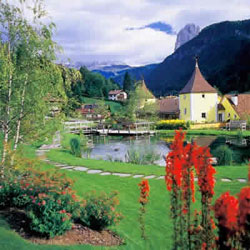 |
| 7th Day: San Marino From Ortisei we will drive south through the regions of Trentino, Lombardia, Emilia Romagna, Tuscany and Umbria and we will stop to visit the republic of St. Marino. San Marino is sited on the boundary between Romagna and the Marche, in a terrain which is predominantly rocky. This independent Republic, in the heart of Italy, has over 1700 years of history. It is one of the smallest states in the world and the oldest European Republic. San Marino's economy relies primarily on its tourist industry and the production of postage stamps. The Republic has a number of Nature Reserves including Pineta di Montecerreto, Parco Zona Ca Lentino, Parco Aiala and the Parco Naturale di Montecchio. The architecture of San Marino is of great historical and artistic importance with buildings such as Palazzo del Governo, the Castle of Guaita, the Museum of the Immigrant, the Museum of Torture, the Ferrari e Abart Museum, the Church of St Francesco, the Church of the Cappuccini, the Basilica del Santo, the Modern Weapon Museum, the Classic Car Museum, the Wax Museum, and the Curiosity Museum. Events of note include the harquebus and crossbow competition held on the Founding Saint's day. Local cuisine uses the Republics own DOC oil and wine. Drive back to Rome. |
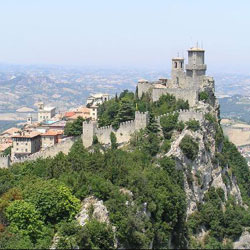 |